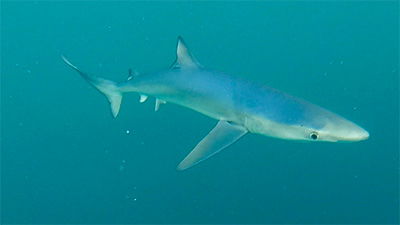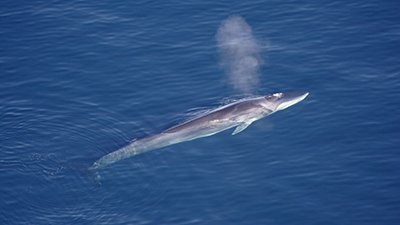How and When Did Baleen Whales Get So Large?
A study published in May in the Proceedings of the Royal Society B hypothesized how and when baleen whales (those which filter feed plankton, krill, and other small creatures) grew so large. Previous hypotheses on the subject had come up with several potential methodologies: change in diet to a particular niche, response to macropredator size, loss of competition for resources, larger intake of food, localized prey density, and so on. They were surprised to discover a correlation between intense wind-driven ocean upwelling and baleen whale body size. They also found that, by comparing baleen whales from the fossil record, today’s giant whales (like the blue whale) grew in size rapidly, starting at about the time of the late Pliocene (supposedly 3 million years ago) through to the late Pleistocene (conventionally dated to 100,000 years ago); the entire time period in Flood geology terms would be during the Ice Age (c. 2300–1900 BC).
The study found that this intensified upwelling brought nutrients up from the ocean bottom, causing localized explosions in the numbers of plankton and krill, which in turn led to opportunistic feeding patterns for baleen whales. Prey densities were restricted to coastal areas though, which meant that whales had to migrate near to continental shelves. This “all you can eat buffet” led to extended times of foraging in prey-dense waters and dramatically increased the body mass of baleen whales quickly. According to coauthor Graham Slater’s explanation, “Such conditions would have offered an evolutionary boon” (really just variation, through adaptation, with the baleen whale kind) and would have favored the larger whales with larger throat pouches. These larger whales were able to outcompete the smaller whales by taking in larger amounts of food at one time. Plus, among endotherms (e.g., warm-blooded creatures) larger body sizes also typically mean slower metabolisms, (the benefits being that the body needs less energy to perform its required functions) while smaller animals tend to have higher pound-per-pound metabolic rates (ironically meaning that the smaller animal has to devote much more time to feeding in order to maintain its body weight). Many larger animals with slower metabolisms live longer, and some Bowhead Whales are believed to have a lifespan of 200 years. Additionally, larger animals have a reduced threat of being preyed upon. So for an aquatic animal, which does not have to be concerned with terrestrial limitations on size, getting bigger when there’s more food available makes sense.
Article coauthor and Stanford University researcher Jeremy Goldbogen’s research was summarized in an NPR article.
They found that around the time baleens began growing larger, the ice ages started. The researchers think changes in climate led to increased runoff and more nutrients pouring into the coasts. At the same time, there was an increase in ocean upwelling, which occurs when wind pushes surface waters off-shore and causing deeper ocean waters underneath surface waters to replace it. Those deep waters are often full of nutrients and food for the whales.
The combination of the ice ages and more upwelling resulted in dense patches of food in the ocean—setting the stage for massive whales to win out.
Scientific American also summarized the Royal Society paper and included some thoughts from R. Ewan Fordyce, a geologist at the University of Otago in New Zealand (who was not involved in the study), stating that “other factors may be involved. For example, windblown, iron-rich dust may have fertilized oceanic phytoplankton and could be worth investigating further.”
From a biblical Flood and post-Flood/Ice Age geology perspective, this study actually seems to corroborate some key principles.
From a biblical Flood and post-Flood/Ice Age geology perspective, this study actually seems to corroborate some key principles. At the end of the Flood, as the waters receded off the continents, there would have been intense erosion carrying increased nutrients scoured off the land and washed into the seas. As noted above, this could have been a catalyst for phytoplankton blooms, which would have spurred larger zooplankton and krill populations.
We’ve pointed out in numerous articles that the post-Flood Ice Age would have had some intense weather patterns associated with it. The main catalyst for the explosive growth of baleen whale body size mentioned in the Royal Society paper is wind-driven ocean upwelling. Ironically, creation researchers have posited and modeled intense winds blowing off the continents, and even hypercanes or hyperclones moving across the oceans as a result of the post-Flood Ice Age. Creation geology models have intense orogeny (mountain building) as well as ocean trenches deepening toward the end of the Flood and continuing on to the present, meaning that the upwelling mentioned in this study would fit well with the timeframe of the early stages of the Ice Age. Interestingly, for over 15 years, creation scientists have also postulated massive dust storms at the end of the Ice Age, which could even account for the supplemental causes of whale growth via phytoplankton blooms, as mentioned in the Scientific American article.
So what does this study really show? Well, the first thing to keep in mind is that the secular time frames mentioned (3 Mya–100,000 years ago) are based on unreliable radiometric dating assumptions, which at best may give relative, not absolute, ages. Secondly, the entire late Pliocene to late Pleistocene timeframe fits within an approximately 400–500-year period in post-Flood/Ice Age chronology. Thirdly, speciation via natural selection, adaptation, and created genetic variety—Created Heterozygosity and Natural Processes (CHNP)— fits the data set of baleen whales diversifying rapidly after the Flood. Perhaps the baleen whale’s size increased in the post-Flood world because of the reasons postulated in this paper, but even if so, these are not evolutionary changes—these are changes within a created kind. Of course it may also be that the (pre-Flood/Flood) fossil record of baleen whales is poorly preserved, and baleen whales were just as large then as now.
We have to keep in mind the assumptions made in the evolutionary worldview, especially in this case concerning whale evolution from a terrestrial animal, and baleen whales evolving from toothed ones. We have written on this subject before, and have pointed out that the standard theories of whale evolution are just-so stories that constantly contradict each other. (Just in the past three months, there have been two baleen whale evolutionary stories, see here and here.) But what does Scripture tell us? That God created all sea creatures on Day Five of Creation Week. Whales did not evolve from a terrestrial (or semi-aquatic) ancestor, but were created fully functional as marine mammals within their kinds.
Then God said, “Let the waters abound with an abundance of living creatures, and let birds fly above the earth across the face of the firmament of the heavens.” So God created great sea creatures and every living thing that moves, with which the waters abounded, according to their kind, and every winged bird according to its kind. And God saw that it was good. And God blessed them, saying, “Be fruitful and multiply, and fill the waters in the seas, and let birds multiply on the earth.” So the evening and the morning were the fifth day. (Genesis 1:20–23 NKJV)

Answers in Genesis is an apologetics ministry, dedicated to helping Christians defend their faith and proclaim the good news of Jesus Christ.
- Customer Service 800.778.3390
- Available Monday–Friday | 9 AM–5 PM ET
- © 2025 Answers in Genesis




